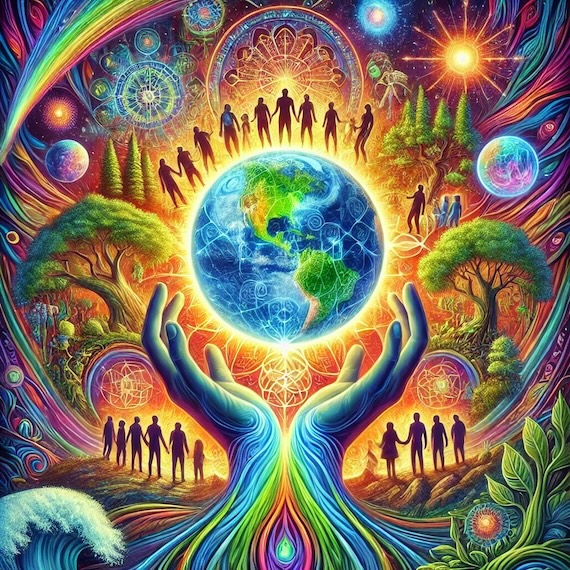Greenfield, Mass. (Special to Informed Comment; Feature) – A postcard I use as a bookmarker contains a set of principles for gardening in urban soils for minimizing risks to human health from exposure to lead and other contaminants. Developed many years ago for Boston Natural Areas Network by Dr. Wendy Heiger-Bernays, a toxicologist, and myself, I now read it on a deeper level–as a prescription for both soil health and human health–and thus, Planet health. For I have come to understand we are part of a whole–the Earth and humans together–and must be saved together.
The Gaia hypothesis supports this. The work of 3 scientists in the late 60s and early 70s, their theory views the Earth as a whole organism in which its living and nonliving parts collaborate to support life on Earth, unexpectedly and improbably. Named for the Greek earth Goddess Gaia, the Mother of all life, the Gaian theory proposes that we humans cannot live our existence as separate from the Earth’s life without consequences that imperil us all.
Gaia revived an ancient concept of the relationship of the Earth and its biosphere found among indigenous peoples throughout the world. The entire range of living matter from whales to viruses, from vast rainforests to algae and nonliving matter (rock, water, ad air) are a single entity that has powers to alter the atmosphere for its ends, and most interesting, are endowed with powers beyond its constituent parts. The gases surrounding our atmosphere enabled life, suffused the world like a breathing, living planetary force. They created an atmosphere optimal for life, unlike the atmosphere of other planets that, so far as we yet know, do not support life. We humans evolved in and are part of this unity.
It worked for life on Earth until the industrial age when some of our human-made technologies gradually severed this unity. The increasing carbon dioxide in the atmosphere from the use of fossil fuels for fuel and hundreds of thousands of synthetic chemicals and the acceleration of extinction among plant and animal species signal humans’ break with nature. The gravity of this break, particularly for certain technologies, is measured annually by the Doomsday Clock
The Doomsday Clock is a “symbolic timepiece showing how close we are to destroying our world” with certain human-made technologies. Set recently at 89 seconds to midnight, it is the closest to midnight the clock has been since it was created in 1947. Why? Because hostility between countries with powerful nuclear weapons has heightened, with many treaties to deter their use abrogated; and climate breakdown continues its downward spiral. The past year (2024), with continued use of fossil fuels and methane emissions, we faced the hottest recorded lands and ocean, triggering catastrophic wildfires, hurricanes, storms, flooding and droughts; and mass migrations. New threats have recently been added by scientists setting the Doomsday clock: artificial information(AI) and the expanding assault on truth through disinformation and conspiracies; and emerging and re-emerging infectious diseases, such as H5N1 bird flu spreading to other animals and humans, as well as “gain of function” research.
In 2025 an alternative to the Doomsday Clock was proposed to change our vantage point from “midnight to dawn.” Code Pink: Women for Peace asserts that seventy-seven years of doomsday warning have not moved our world’s decisionmakers in a peaceable direction, with the exception of President Kennedy. Why not highlight “the many possibilities and missed opportunities to create the new dawning of a Peace Day.” They propose actionable steps to move the clock’s hand toward a livable world.

“Earth and Humans Saved,” Digital, Dall-e, 2025
Their recommendations include treaties banning weapons in space to a deal with Russia in which the US removes nuclear weapons from five NATO states and Russia removes recently placed weapons in Belarus. Ultimately, they demand nothing short of the abolition of nuclear weapons, as we move to a nuclear free world at peace unthreatened by catastrophic annihilation.
Their effort is crucial. But something more than changing our vantage point from “midnight to dawn” is needed: a worldview that includes Nature.
Our constitution (as threatened as it is by the extreme fascism of the hyper-wealthy) establishes a doctrine of rights exclusively for humans while ignoring, denying even, the comparable rights of Nature. Nothing in this universe survives by itself: not viruses, algae, blue whales, vast rainforests, nor humans. We need to see ourselves as intimately bonded with the Earth and the Universe, as living in union with it. This worldview, a salvific one, will caution us from depleting the Earth by the objectifying and trivializing of it that consumer capitalism and corporate avarice sells. It would deter us from dominance and hostility toward other nations and incline us to multilateralism and diplomacy in working toward peace.


 © 2025 All Rights Reserved
© 2025 All Rights Reserved